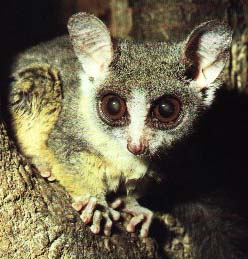These African primates are small, quick animals that are still relatively common in many areas. The family contains 4 genera and 11 species. It is often associated with -- and sometimes included as a subfamily within -- the Loridae (which, to make matters more confusing, is also sometimes known as the Lorisidae).
Galagonidae
galagos, bushbabies
Galagos have long hindlegs (noticeably longer than their forelimbs) and a long tail. Their bodies are lightly built compared to the heavier lorids. The ears are large and mobile. Their fingers are well developed but more slender than in lorids. They have terminal disk-pads, and the pollux (thumb) is not opposable. In contrast to lorids, galagos do not have retia mirabilia in their hind limbs. As in most other strepsirhines, their hind feet include a modified "toilet claw." Galagos move rapidly through the trees, leaping from branch to branch (up to 12 meters!). This also contrasts with lorids, which move slowly and rarely leap.
The smallest member of this family, the dwarf bushbaby, weighs only around 60 g, while the largest, the thick-tailed bushbaby, may weigh up to around 1.2 kg. Their fur is soft and wooly, darker on the dorsal surface than the ventral, and ranging from gray to brown.
The skulls of galagos are lightly built with a globular braincase and without strongly developed temporal ridges. The facial region is reduced. The orbits are directed more to the sides than in lorids. Their postorbital processes and zygomatic arches are slender, and the bullae are considerably inflated. Unlike lorids, the zygomatic branch of the squamosal lies entirely anterior to the external auditory meatus; and the palate usually ends behind the second rather than the third upper molar.
As in the case of most other strepsirhines, galagos have a toothcomb made up of lower incisors and canines. Their molars are similar to those of lorids. The dental formula of bushbabies is 2/2, 1/1, 3/3, 3/3 = 36.
Male galagos have a baculum, a structure that male lorids lack.
Galago species vary in food habits from being highly insectivorous to eating leaves, fruit, or gums secreted by trees. Some forage low in undergrowth; others are seen mainly in the canopy. The hands and feet of some species appear to be specialized for grasping small twigs and branches, but one species (Galago elegantulus) climbs mostly on large branches and the trunks of trees. Most of their activity is nocturnal; during the day, they can be found in thick vegetation or hollow trees.
As far as is known, bushbabies live in small groups of 7 to 9 individuals, but only a few species have been studied. Scent, vocalizations, and facial expressions all play a role in social communication.
HOME
Primates
Primate FAQ
Primate Species
Bushbaby Pictures
Search Primates.com
Primates E-Mail Service
